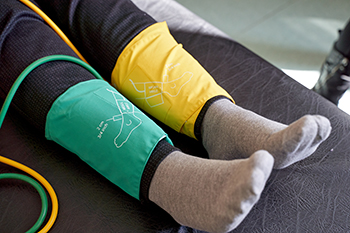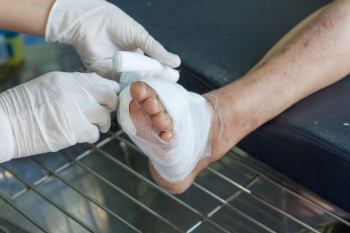Connect With Us
Blog

Peripheral artery disease, or PAD, is a condition characterized by narrowing or blockage of the arteries, typically in the legs, due to the buildup of fatty deposits. This restricts blood flow to the limbs, affecting the feet and causing various symptoms. Those at risk include smokers, diabetic patients, individuals with high blood pressure or cholesterol, and those with a family history of cardiovascular disease. Symptoms may include leg pain, cramping, numbness, weakness, or coldness in the feet and legs, especially during physical activity. However, some people with PAD may not experience any symptoms, a condition known as asymptomatic PAD. A podiatrist evaluates PAD through a comprehensive consultation, which may include assessing symptoms, and medical history, and performing tests like ankle-brachial index measurements or Doppler ultrasound to determine blood flow. Treatment focuses on managing symptoms, improving circulation, and reducing the risk of complications through lifestyle changes, medications, or surgical interventions. If you suffer from foot symptoms of PAD, it is suggested that you schedule an appointment with a podiatrist for care.
Peripheral artery disease can pose a serious risk to your health. It can increase the risk of stroke and heart attack. If you have symptoms of peripheral artery disease, consult with Dr. Michael D. Garvin from Florida. Our doctor will assess your condition and provide you with quality foot and ankle treatment.
Peripheral artery disease (PAD) is when arteries are constricted due to plaque (fatty deposits) build-up. This results in less blood flow to the legs and other extremities. The main cause of PAD is atherosclerosis, in which plaque builds up in the arteries.
Symptoms
Symptoms of PAD include:
- Claudication (leg pain from walking)
- Numbness in legs
- Decrease in growth of leg hair and toenails
- Paleness of the skin
- Erectile dysfunction
- Sores and wounds on legs and feet that won’t heal
- Coldness in one leg
It is important to note that a majority of individuals never show any symptoms of PAD.
Diagnosis
While PAD occurs in the legs and arteries, Podiatrists can diagnose PAD. Podiatrists utilize a test called an ankle-brachial index (ABI). An ABI test compares blood pressure in your arm to you ankle to see if any abnormality occurs. Ultrasound and imaging devices may also be used.
Treatment
Fortunately, lifestyle changes such as maintaining a healthy diet, exercising, managing cholesterol and blood sugar levels, and quitting smoking, can all treat PAD. Medications that prevent clots from occurring can be prescribed. Finally, in some cases, surgery may be recommended.
If you have any questions, please feel free to contact our offices located in Port St. Lucie, FL . We offer the newest diagnostic and treatment technologies for all your foot care needs.

Preventing slips, trips, and falls is essential for avoiding injuries, including those that are foot-related. Falls account for nearly one-third of non-fatal injuries in the United States, highlighting the importance of proactive measures to mitigate risks. In the home, maintaining good housekeeping practices and promptly addressing spills or leaks can significantly reduce the likelihood of accidents. Proper maintenance of flooring and walking surfaces is also essential to prevent slips and trips. Differentiating between slip-resistant footwear for wet or slippery conditions and shoes with proper traction for outdoor activities can further enhance safety. By prioritizing preventive measures, individuals can safeguard against falls and protect their overall well-being. If you have sustained a foot-related injury from a slip, trip, or fall, it is suggested that you schedule an appointment with a podiatrist for treatment. This medical professional can provide valuable guidance on footwear selection and foot care practices to improve stability and reduce the risk of falls, especially for individuals with underlying foot conditions or mobility issues.
Preventing falls among the elderly is very important. If you are older and have fallen or fear that you are prone to falling, consult with Dr. Michael D. Garvin from Florida. Our doctor will assess your condition and provide you with quality advice and care.
Every 11 seconds, an elderly American is being treated in an emergency room for a fall related injury. Falls are the leading cause of head and hip injuries for those 65 and older. Due to decreases in strength, balance, senses, and lack of awareness, elderly persons are very susceptible to falling. Thankfully, there are a number of things older persons can do to prevent falls.
How to Prevent Falls
Some effective methods that older persons can do to prevent falls include:
- Enrolling in strength and balance exercise program to increase balance and strength
- Periodically having your sight and hearing checked
- Discuss any medications you have with a doctor to see if it increases the risk of falling
- Clearing the house of falling hazards and installing devices like grab bars and railings
- Utilizing a walker or cane
- Wearing shoes that provide good support and cushioning
- Talking to family members about falling and increasing awareness
Falling can be a traumatic and embarrassing experience for elderly persons; this can make them less willing to leave the house, and less willing to talk to someone about their fears of falling. Doing such things, however, will increase the likelihood of tripping or losing one’s balance. Knowing the causes of falling and how to prevent them is the best way to mitigate the risk of serious injury.
If you have any questions, please feel free to contact our offices located in Port St. Lucie, FL . We offer the newest diagnostic and treatment technologies for all your foot care needs.

Foot care is a critical aspect of diabetic management, as individuals with diabetes are prone to foot comp-lications. Maintaining skin integrity is essential, especially in diabetic feet where issues like neuropathy and poor circulation can lead to ulcers, infections, and possibly even amputations. Preventive care and regular screening are paramount in mitigating risks. A multidisciplinary team, including podiatrists, plays a pivotal role in diabetic foot care. Podiatrists specialize in assessing foot health, identifying early signs of complications, and providing tailored interventions. They offer expertise in wound care, orthotic management, and footwear recommendations, all aimed at preventing and managing foot problems. By emphasizing preventive measures, such as daily foot inspections, proper hygiene, and appropriate footwear, podiatrists collaborate with patients to minimize the likelihood of diabetic foot complications. If you are a diabetic patient, it is strongly suggested that you schedule regular appointments with a podiatrist as part of your diabetes management.
Wound care is an important part in dealing with diabetes. If you have diabetes and a foot wound or would like more information about wound care for diabetics, consult with Dr. Michael D. Garvin from Florida. Our doctor will assess your condition and provide you with quality foot and ankle treatment.
What Is Wound Care?
Wound care is the practice of taking proper care of a wound. This can range from the smallest to the largest of wounds. While everyone can benefit from proper wound care, it is much more important for diabetics. Diabetics often suffer from poor blood circulation which causes wounds to heal much slower than they would in a non-diabetic.
What Is the Importance of Wound Care?
While it may not seem apparent with small ulcers on the foot, for diabetics, any size ulcer can become infected. Diabetics often also suffer from neuropathy, or nerve loss. This means they might not even feel when they have an ulcer on their foot. If the wound becomes severely infected, amputation may be necessary. Therefore, it is of the upmost importance to properly care for any and all foot wounds.
How to Care for Wounds
The best way to care for foot wounds is to prevent them. For diabetics, this means daily inspections of the feet for any signs of abnormalities or ulcers. It is also recommended to see a podiatrist several times a year for a foot inspection. If you do have an ulcer, run the wound under water to clear dirt from the wound; then apply antibiotic ointment to the wound and cover with a bandage. Bandages should be changed daily and keeping pressure off the wound is smart. It is advised to see a podiatrist, who can keep an eye on it.
If you have any questions, please feel free to contact our offices located in Port St. Lucie, FL . We offer the newest diagnostic and treatment technologies for all your foot care needs.
Blog Archives
- April 2024
- March 2024
- February 2024
- January 2024
- December 2023
- November 2023
- October 2023
- September 2023
- August 2023
- July 2023
- June 2023
- May 2023
- April 2023
- March 2023
- February 2023
- January 2023
- December 2022
- November 2022
- October 2022
- September 2022
- August 2022
- July 2022
- June 2022
- May 2022
- April 2022
- March 2022
- February 2022
- January 2022
- December 2021
- November 2021
- October 2021
- September 2021
- August 2021
- July 2021
- June 2021
- May 2021
- April 2021
- March 2021
- February 2021
- January 2021
- December 2020
- November 2020
- October 2020
- September 2020
- August 2020
- July 2020
- June 2020
- May 2020
- April 2020
- March 2020
- February 2020
- January 2020
- December 2019
- November 2019
- October 2019
- September 2019
- August 2019
- July 2019
- June 2019
- May 2019
- April 2019
- March 2019
- February 2019
- January 2019
- December 2018
- November 2018
- October 2018
- September 2018
- August 2018
- July 2018
- June 2018
- May 2018
- April 2018
- March 2018
- February 2018
- January 2018
- December 2017
- November 2017
- October 2017
- September 2017
- August 2017
- July 2017
- June 2017
- May 2017
- April 2017
- March 2017
- February 2017
- January 2017
- December 2016
- November 2016
- October 2016
- September 2016
- August 2016

